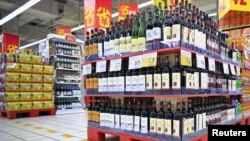The crates of Chateau Brehat wine from Bordeaux had gathered dust for three years in a bonded warehouse on the outskirts of Shanghai before the owners cut their losses in July, slashing three-quarters off the $50 price tag.
The fire sale was prompted by a huge oversupply of wine that had built up after a swarm of importers jumped at seemingly stellar growth from 2010. China wine consumption - which had been rising in double digits - dropped last year and is set to inch up just over 1 percent annually until 2020.
The striking slowdown is a headache for a global wine industry pinning hopes on fast China growth, and a further sign that Chinese consumers are reining in spending even as Beijing hopes they will pick up the slack from falling exports.
"When we started there was huge demand so we could control prices, big margins no problem," said Xavier Grangier, sales director at logistics firm Europasia, which runs the 4,000-sq-meter (43,000-sq- ft) Shanghai warehouse storing 250,000 bottles of mostly European wine.
Now, his firm has had to lower some prices and been stuck with some wine it is unlikely to sell.
"In Shanghai alone, 2,000 firms in the wine business just vanished over the last couple of years," he added.
China's retail wine market is worth around 78 billion yuan ($12.3 billion), with imports making up around a third, according to a 2015 report from wine data analytics firm IWSR.
High Price Tags
While official retail sales figures have been a rare bright spot amid a stream of economic data showing China's economy faltering, private sector surveys have shown consumer sentiment plumbing record lows in recent months.
A crackdown on corruption now in its third year has also discouraged conspicuous consumption, hitting not just wine but also sellers of other luxury goods from LVMH and Burberry to global auto makers.
"In 2010 everyone was screaming from the rooftops that China was the El Dorado for wine and you could become a millionaire by jumping into the business," said Pierrick Fayoux, Shanghai-based marketing manager at French wine importer VGF China Ltd.
"Now wine is being sold below cost, some is going bad sitting for long periods in poorly maintained warehouses and decent Bordeaux wines are going for 15 yuan a bottle," he added.
To be sure, China's wine industry has long-term potential: the market is already the world's fifth largest, but with only 38 million wine drinkers - mostly in big cities such as Shanghai, Beijing and Tianjin - among a population of 1.4 billion, annual consumption per capita is only 5.8 liters, a fraction of the 50 liters consumed in France.
For now though, the inventory overhang and the downward pressure on prices is making it hard to turn a profit.
Even China's biggest wine importer, ASC Fine Wines, has trimmed prices and taken a hit to its margins, a person with direct knowledge of the firm's operations told Reuters.
ASC, owned by Japan's Suntory Beverage & Food Ltd., said the wine market was in a new slower stage of growth and that consumers were increasingly "price-conscious."
"We are expanding our entry-level wine selections to meet the changes in consumer demand," said ASC's chief executive officer Bruno Baudry in emailed comments to Reuters.
New World Order?
The squeeze on prices could be better news for more affordable New World wines, with countries such as Chile and South Africa already taking more market share with wines under 100 yuan ($15).
"There is still demand for imported wine, but not the same wines," said Guillaume Deglise, CEO of Vinexpo, which organizes wine fairs to help introduce producers to China buyers. "Before it was mostly the luxury end of the business - up-market wines from Bordeaux. Now it's the entry-level market."
Import volumes have started to pick up in 2015, but average price are still falling as consumers tighten their belts.
In response, Australia's Treasury Wine Estates Ltd. has lowered prices and trimmed inventories, helping revive profits in the market.
"We now track our inventory by partner and by customer monthly, so we know if their inventory is too high," Robert Foye, Treasury Wine's managing director for Asia and other regions told Reuters in an interview in Shanghai. The firm owns brands such as Penfolds, Lindeman's and Wolf Blass.
With the world's largest middle-class, he said China would become an increasingly key market for the firm, even though the culture of wine drinking is still relatively new.
"Normally I drink beer or baijiu, it's very rare that I'd have a glass of wine," said Xu Fengqi, 50, who lives in the northeastern port city of Dalian.
Friends sometimes gave him wine as a gift, he added, but he rarely bought it himself.
"Even then, we often find we haven't actually got a bottle opener, and one time when I tried to open the bottle I pushed too hard and the cork ended up floating in the wine," he added.
($1 = 6.3517 Chinese yuan renminbi)











